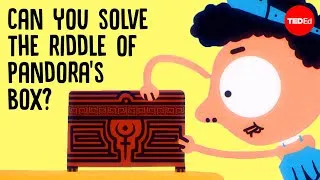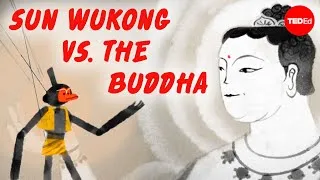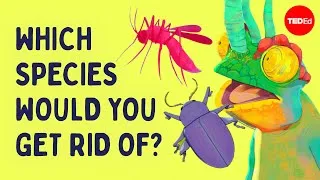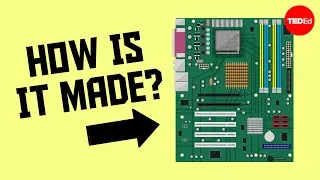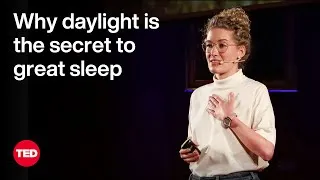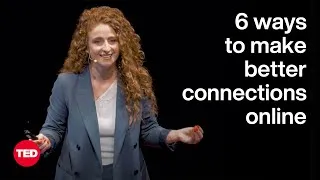請雙擊下方英文字幕播放視頻。
譯者: Camila Lin
審譯者: Bruce Sung
00:07
Every color you see in front
of you can be found in nature.
0
7670
3379
你眼前的所有顏色,
都能在大自然中找到。
00:11
Some plant, animal, or mineral
bears almost every hue imaginable.
1
11049
4295
有些植物、動物、礦物,
含有你能想像到的幾乎所有顏色。
00:15
But which of these colors are you
least likely to see in the natural world?
2
15762
4296
但在這些顏色之中,
哪一種顏色最難在自然中發現?
00:20
There are two factors that drive
the rarity of color in nature:
3
20767
3586
自然顏色的稀有度,
主要由兩個因素決定:
00:24
physics and evolution.
4
24687
2002
物理和演化。
00:27
Let’s start with physics.
5
27023
1585
讓我們先來看看物理學。
00:29
Colors are generated when wavelengths
of light interact with objects,
6
29859
3962
顏色是光的波長
和物體表面互動的結果。
00:33
and most of the colors
you’ve seen outside a screen
7
33821
2461
你在螢幕外看見的大多數顏色,
00:36
were produced in one of two ways.
8
36282
2127
由兩種方式產生。
00:38
In absorption-based colors,
9
38409
1877
就基於吸收而產生的顏色來說,
00:40
certain wavelengths are absorbed
by an object, while others are not.
10
40286
4213
物體會吸收特定波長的光波,
而反射其他波長的光波。
00:44
The result is a matte final color
generated by these leftover light waves.
11
44624
4504
這些被反射的光波彼此混合,
產生最終顯示的顏色。
00:49
Most naturally occurring colors
fall into this category,
12
49462
3045
大多數的自然顏色都是這樣產生,
00:52
including those of many fruits
and flowers.
13
52507
2252
包括許多水果和花卉的顏色。
00:55
Plants are full of compounds called
pigments that absorb light waves
14
55301
3420
植物飽含名為「光合色素」的化合物,
用來吸收光線,作為光合作用的一環。
00:58
as part of photosynthesis,
15
58721
1627
01:00
the process by which
they convert sunlight into energy.
16
60348
2919
光合作用能將陽光轉化為能量。
01:03
While different plants have evolved
different pigments
17
63601
2586
由於不同植物演化出不同的色素,
01:06
that result in different colors,
18
66187
1835
所以它們呈現的顏色也不同,
01:08
higher energy wavelengths are more easily
absorbed than lower energy ones.
19
68106
4879
較高能量的波長,
比較低能量的光更容易被吸收。
01:13
And blue light has some
of the highest energy wavelengths
20
73277
2711
而在可見光中,
藍光是能量最高的光波之一。
01:15
in the visible spectrum.
21
75988
1460
01:17
Numerous pigments have evolved
to absorb blue light,
22
77657
2919
許多光合色素演化出吸收藍光的功能,
01:20
including chlorophyll, which absorbs blue
and red wavelengths
23
80576
2920
例如能吸收紅光和藍光的葉綠素,
01:23
to produce nature’s trademark green.
24
83496
2210
製造出大自然的標誌性綠色。
01:26
However, green light is still
fairly energetic,
25
86374
3128
但是,綠光的能量也不低,
01:29
and the most common class of pigments
evolved to absorb these wavelengths
26
89502
3712
因此最常見的光合色素也都演化出
吸收綠光的功能。
01:33
as well.
27
93214
1001
01:34
There are over 1,100 types
of carotenoids,
28
94549
4045
有超過 1100 種類胡蘿蔔素,
01:38
pigments which absorb high energy
blue and green light,
29
98594
3504
這是一種能吸收高能量的藍光與綠光,
01:42
while leaving behind the lower energy
red and yellow light.
30
102098
3670
同時反射低能量的
紅光與黃光的光合色素。
01:46
While carotenoids are present
in most green plants,
31
106227
2836
雖然幾乎每種植物都含有類胡蘿蔔素,
01:49
they only become visible each fall
when chlorophyll gets broken down
32
109063
4379
但要到每年秋天,植物為了
儲備過冬能量而分解葉綠素時,
01:53
to save energy for the winter.
33
113442
2044
我們才能看見它們的顏色。
01:55
But whether they’re working alone
or side by side,
34
115820
2836
但無論這些光合色素
是分工合作,或是單打獨鬥,
01:58
these pigments absorb
blue light in virtually all plants.
35
118656
3837
幾乎所有植物都會吸收藍光。
02:02
Even fruits and flowers that appear blue
36
122577
2502
就算是看似藍色的水果或花朵,
02:05
actually have pigments
that are red or purple,
37
125079
2836
其實也含有紅色或紫色的色素,
02:07
and only truly turn blue
under specific chemical conditions.
38
127915
3963
並只在特定化學條件下才會變成藍色。
02:12
So, is blue the rarest color
in nature?
39
132879
3420
所以藍色是自然中最稀有的顏色嗎?
02:16
Not quite.
40
136799
1168
還不能下定論。
02:18
Absorption is just one of the two
main ways light generates color.
41
138426
4463
吸收只是光產生顏色的其中一種方法。
02:23
In the second method, some wavelengths
are scattered and amplified—
42
143306
4129
第二種方法中,
某些光波被散射、放大,
02:27
overpowering the others to determine
an object's final color.
43
147435
3462
凌駕於其他光波之上,
決定了物體最終的顏色。
02:31
These structural colors occur
44
151606
2252
這些結構色之所以產生,
02:33
because some objects around us are made
of microscopic particles
45
153858
3545
是因為我們周遭的
某些東西由微粒組成,
02:37
which can form nanostructures
that interfere with visible light.
46
157403
4171
能產生奈米結構,和可見光相互作用。
02:42
For example, this feather has
no blue pigments in it.
47
162158
3920
例如,這根羽毛並不含藍色的色素。
02:46
But when light strikes it,
the electrons within its nanostructure
48
166078
4088
但光照射在羽毛上時,
羽毛奈米結構中的電子
02:50
vibrate at the same frequency
as the weight.
49
170166
3378
會用和光波相同的頻率震動。
02:53
This makes the particles send
out a new wave with the same frequency,
50
173544
4338
因此,粒子也會發射相同頻率的新波,
02:57
starting a chain reaction that amplifies
and scatters blue light.
51
177882
4296
開始一段能放大、
折射藍光的連鎖反應。
03:03
Nanostructures of various shapes and sizes
scatter different wavelengths,
52
183387
4129
不同形狀和尺寸的奈米結構,
會折射出不同波長,
03:07
but they typically scatter high-energy
wavelengths most easily—
53
187516
4046
但它們通常最容易折射高能量的光波,
03:11
making blue
the most common structural color.
54
191562
3837
讓藍光成了最常見的「構造色」。
03:16
Meanwhile, low-energy wavelengths
like red are only weakly scattered.
55
196108
4255
而紅色這種低能量的光波,
折射力道通常很弱。
03:20
Even when something evolves
specific nanostructures
56
200780
2794
就算有東西演化出特別的奈米結構,
03:23
that strongly scatter red light
57
203574
1752
能折射出強烈的紅光,
03:25
they still resonate
with other wavelengths,
58
205326
2336
這些結構仍會和其他波長的光共振,
03:27
only appearing red at some angles
of illumination and observation.
59
207954
4212
只能以某些角度照明、觀察,
才能看見紅色。
03:32
This gives us two contenders
for nature’s rarest color:
60
212667
3503
這讓我們看見自然界
最稀有顏色的兩個競爭者:
03:36
absorption-based matte blues
and structural iridescent reds.
61
216170
4379
因吸收混合出的藍色,
以及結構色中的紅色。
03:41
Between these two,
structural reds are much rarer.
62
221008
3796
以這兩者來說,結構色的紅色更稀有。
03:45
Only a handful of animals and rocks
scatter red light
63
225012
3504
只有少數動物和石頭能折射出紅光,
03:48
and none of them scatter
red light exclusively.
64
228516
2544
但沒有一種物體能只折射出紅光。
03:51
But since red and blue are rare
in one way and common in another,
65
231060
4713
在兩種形成顏色的方式中,紅色
和藍色各是一種稀缺另一種普遍,
03:55
we actually end up seeing
both colors quite often.
66
235773
3212
因此我們仍能時常看見紅色與藍色。
03:59
So what color is least likely
to be generated
67
239944
2878
所以,究竟是哪種顏色最難製造,
04:02
in structural and absorption-based forms?
68
242822
3170
不管是以結構色還是吸收色而言?
04:06
The answer is violet.
69
246409
2294
答案是藍紫色。
04:08
Not to be confused with purple, which is
just a combination of red and blue light,
70
248911
4213
可別把它誤認成
紅光和藍光混合出的紫色。
04:13
violet occupies a small portion
of the visible light spectrum.
71
253124
4421
藍紫光也是可見光譜裏的小小一員。
04:17
There are only a few nanostructures
precise enough
72
257920
2711
只有少數夠精確的納米結構,
04:20
to exclusively scatter violet light.
73
260631
2836
才能特別散射出藍紫光。
04:23
And violet wavelengths are even
more energetic than blue ones,
74
263467
3462
藍紫光的能量比藍光更強,
04:27
making them likely to be absorbed
by pigment.
75
267179
2294
因此更容易被光合色素吸收。
04:30
So if you ever stumble
onto the iridescent violet wings
76
270224
3837
所以如果你碰巧看到
紫帝王蝶的藍紫色雙翅,
04:34
of a purple emperor butterfly,
77
274061
2544
04:37
take a second to appreciate
one of nature’s rarest spectacles.
78
277398
5047
就花點時間,欣賞
大自然中最獨特的奇觀吧。
New videos
關於本網站
本網站將向您介紹對學習英語有用的 YouTube 視頻。 您將看到來自世界各地的一流教師教授的英語課程。 雙擊每個視頻頁面上顯示的英文字幕,從那裡播放視頻。 字幕與視頻播放同步滾動。 如果您有任何意見或要求,請使用此聯繫表與我們聯繫。


